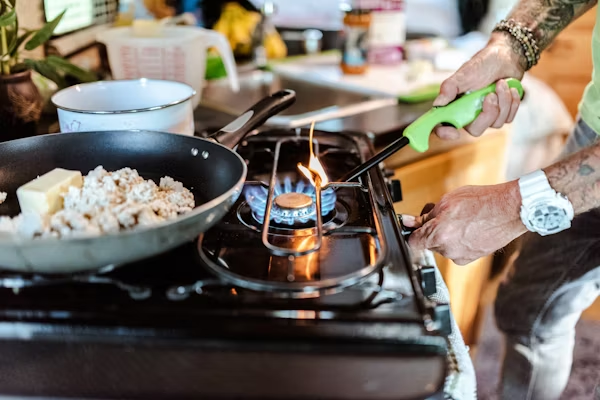Travel
Weekend Warrior Strategy – Upgrade to Business Class for Short Trips

Your weekend can feel epic even if the calendar barely budges. The secret is squeezing every ounce of comfort and time out of a short hop, then arriving ready to play tour guide, foodie, and nap connoisseur without ever yawning through dinner. Upgrading your seat is a power move. It changes the whole vibe. Suddenly the airport soundtrack softens, queues seem kinder, and your weekend brain snaps into vacation mode before wheels lift. You step off energized, not scrambled.
If you want the smoothest path from idea to aisle, check this website and compare the smartest fares through Business-Tickets. You will see cabins, aircraft, and timing lined up clearly, so you can pounce on value without juggling twelve tabs and a growing headache.
Build Upgrade Momentum Before Your Weekend Even Begins
Think like a sprinter, not a marathoner. Short trips reward quick decisions and flexible thinking. Keep your options open, and let your itinerary bend a little so your seat can treat you a lot.
- Pick flights with historically lighter loads.
- Watch price drops during midweek afternoons.
- Choose fare classes upgrade eligible.
- Track aircraft with better business cabins.
- Hold seats, then recheck award space.
These tiny nudges add up fast. Suddenly your quick getaway looks like a mini retreat with a welcome drink and a proper blanket.
Turn Short Flights Into Big Comfort Without Big Prices
The magic of upgrading a short trip is that the cost often stays friendly while the comfort leaps skyward. Think priority lanes, peaceful lounges, and that glorious moment when your seat reclines and your shoulders unclench. Even a short hop becomes a calm pocket where emails wait, shoulders loosen, and you remember travel can feel simple, human, and oddly joyful again.
- Use miles to top up.
- Mix cash with miles wisely.
- Compare nearby airport options.
Be flexible by a few hours and you might snag a cabin that feels custom built. The difference between a cramped commute and a relaxing glide is often one smart search using Business-Tickets.
Play The Gate Game With Polite Confidence
Upgrades are part strategy and part theater. You prepare well, then deliver your best smile at the right moment. Gate agents juggle a thousand moving pieces; kindness travels far.
Frequent weekend flyers often score last-minute paid upgrades; Travel + Leisure notes that asking again at the gate can still secure a lie-flat seat, while savvy travelers check this website first to benchmark real-time fare floors.
A few etiquette wins help enormously. Dress like you belong, arrive early, and have a clear ask. If there is space, you will hear angels sing. If not, you still board first in spirit.
Lock The Win And Maximize Every Precious Hour
The point of your weekend upgrade is not just comfort. It is time. You want more of it for brunch, galleries, soccer, or blissful nothing. Treat your booking like a game plan and make each minute count.
- Preselect seats near faster exits.
- Choose terminals with better lounges.
- Pack light to avoid carousels.
- Set alerts for return upgrades.
- Schedule arrivals outside rush windows.
- Keep backup rideshare or train plans.
Now your Friday evening starts at takeoff instead of after baggage claim. And your Sunday night ends with you feeling smugly human, not travel-wrecked. Business-Tickets keeps the comparisons honest, the choices simple, and the deals within reach, so your short trip acts like a long vacation. Next thing you know, you are back home telling friends you blinked and somehow fit an entire adventure between breakfast and Monday.
Travel
Gap year ahead? 5 crucial tips every parent must know before their child jets off

A gap year is a fantastic opportunity for young travellers to experience other cultures and gain new experiences and independence. But for parents, it often brings a wave of worry alongside the excitement.
To help families prepare for this big step, Sarah Rodrigues, a travel expert working with Avanti Travel Insurance, shares her top tips for supporting young adults as they head off on their travels.
Sort Travel Insurance First
Before anything else, Sarah advises getting comprehensive travel insurance tailored to your child’s destination and length of stay:
“Start with travel insurance: be sure to take out a comprehensive policy that caters for the countries they’re visiting and length of trip. It should cover things like their belongings, emergency medical expenses, repatriation, trip cancellation, curtailment and any adventurous activities, such as hiking or scuba diving, that they might want to try. If they have any pre-existing medical conditions, including food allergies, asthma, or diabetes, declare them on the policy. It’s worth keeping a copy of the policy yourself and making sure you both know how to access the emergency contact numbers if needed.”
Travel insurance policies can only be purchased by individuals aged 18 or older. For travellers under 18, a parent or guardian must purchase the policy on their behalf. However, if the traveller is 18 or older, they will need the traveller’s consent to access any details related to the policy.
And don’t forget the health essentials. Make sure they’re up to date on recommended vaccinations for their destination, and pack enough prescription medication to last the trip, along with a basic first aid kit.
Create Copies of Important Documents
Losing a passport or other important documents can be distressing, especially when abroad.
Sarah suggests: “It’s a good idea for both of you to have digital and printed copies of all their important documents like their passport, visa, insurance, driving licence and emergency contact details. If something gets lost or stolen, having quick access to that information can make a big difference.”
Make sure they’ve saved these securely, and that you have copies too in case of emergency.
Discuss Money Management
Managing money abroad is another learning curve. Sarah suggests using prepaid travel cards for safety and ease.
“Discuss how they’ll manage money abroad. Prepaid travel cards can be a safe and convenient option: not only do they help with budgeting, but they are also easier to replace than bank cards if they get lost.”
If they plan to use online banking, remind them to stick to secure networks and avoid logging in on public Wi-Fi.
Have Tough Conversations
Some topics can feel awkward to bring up but they’re just as important as flights and packing lists.
“Talking about safe sex may not be the most comfortable conversation to have, but it’s a necessary one. Not only do adolescents need to be fully aware of issues of consent, but they should also know where and how they can access items such as condoms on their travels, as well as how to get sexual health advice at a clinic, if necessary.”
Alcohol can also pose unexpected risks abroad, particularly with reports of counterfeit or unregulated drinks circulating in some regions.
“Given recent reports of home brewed alcohol with dangerous substances such as methanol laced drinks in hostels can pose a serious risk. Educating them about the dangers of accepting unbranded or unregulated drinks is important and doing their research of the local area before they go is crucial. While backpacking and drinking may go hand in hand for some, they should be aware that consuming too much alcohol could not only put them in dangerous situations but also lead to serious health issues. They should also know that accidents and injuries abroad that occur from over excessive drinking may invalidate their travel insurance if they’re found to be intoxicated.”
If you make a claim for an unexpected incident that happened while you were under the influence, your provider may not cover it. So, it’s important to remember that and urge them to stay safe.
And while tattoos and piercings can feel like part of the gap year adventure, they come with health warnings too.
“Additionally, no matter what your personal feelings are about body art, tattoos and piercings are often gap year rites of passage. Talk to your children about hygiene and safety tips to reduce the risk of infection. Keeping a tattoo covered, clean and out of water and sunlight help the healing process. It’s also worth mentioning that their travel insurance is unlikely to cover them if they need medical treatment which has been caused by a tattoo or piercing so it may be best to wait till they get home.”
Research Local Customs and Laws
Finally, she says:
“Research the countries they’re visiting. Understanding local customs, basic laws and safety tips can help them avoid issues allowing them to get more out of their travels. A little preparation goes a long way and will help them feel more confident navigating new places.”
This includes respecting dress codes and religious practices, which can vary widely between countries.
Letting your child head off on a gap year is a big milestone for them and for you. By taking time to prepare together, you can help make their trip as safe and rewarding as possible.
Food
Air Fryer Inspiration: A Complete Recipe Roundup for Healthier Cooking

Air fryers have quickly become one of the most beloved kitchen appliances, offering a healthier way to enjoy comfort foods without sacrificing flavor or crunch. From perfectly crisp fries to tender proteins and even surprising desserts, air fryer recipes have revolutionized home cooking. If you’re searching for inspiration, this recipe roundup brings together some of the best air fryer dishes to try. Each one showcases how versatile and time-saving this small but powerful appliance truly is.
Why Air Fryer Recipes Are So Popular
The air fryer works by circulating hot air around food, creating a crispy exterior similar to deep frying but with little to no oil. This not only makes meals lighter and healthier but also cuts down on cooking time. The result? Crunchy textures, juicy interiors, and fewer calories—all from one compact device.
Whether you’re cooking for family, meal prepping, or simply looking for quick snacks, air fryer recipes can fit seamlessly into your lifestyle. Best of all, they’re easy to experiment with, allowing both beginners and seasoned cooks to explore new dishes.
Classic Comfort Foods in the Air Fryer
1. Air Fryer French Fries
No air fryer roundup is complete without mentioning fries. Homemade air fryer French fries are crisp on the outside and fluffy on the inside without the greasy heaviness of deep frying. All you need are potatoes, a drizzle of oil, and your favorite seasonings.
2. Crispy Chicken Wings
Game nights or casual get-togethers call for air fryer chicken wings. They cook up golden and crunchy in under 25 minutes. Toss them in buffalo sauce, garlic parmesan, or a honey barbecue glaze for an irresistible snack.
3. Onion Rings
Love the crunch of onion rings? The air fryer delivers perfectly coated, crunchy bites without the mess of a deep fryer. A panko breadcrumb coating ensures extra crispiness while keeping them light.
Lean Proteins Made Easy
4. Salmon Fillets
Air-fried salmon is quick, healthy, and packed with flavor. A simple seasoning of lemon, garlic, and herbs makes the fish flaky inside with a seared exterior. Pair it with vegetables for a wholesome dinner.
5. Chicken Breasts
Perfectly juicy air fryer chicken breasts are a lifesaver for meal prep. Marinate them ahead of time or use a dry rub. Cooking them in the air fryer prevents over-drying and locks in flavor.
6. Steak Bites
Want restaurant-quality steak without firing up the grill? Air fryer steak bites cook in minutes and taste incredible with garlic butter or chimichurri sauce. They’re perfect for dinner or as a protein-packed snack.
Healthy and Creative Veggie Dishes
7. Roasted Brussels Sprouts
These caramelized little gems come out tender with crispy edges. Add balsamic glaze or Parmesan cheese for an elevated touch.
8. Zucchini Chips
A healthier alternative to potato chips, zucchini chips are crunchy, savory, and addictive. Just slice thin, season, and air fry until crisp.
9. Stuffed Peppers
Bell peppers stuffed with quinoa, black beans, and spices cook evenly in the air fryer, making them a hearty vegetarian meal option.
Unexpected Air Fryer Recipes
10. Air Fryer Donuts
Yes, you can make donuts in an air fryer! Using biscuit dough or homemade batter, these donuts come out light and fluffy without deep frying. A quick glaze or cinnamon sugar topping makes them irresistible.
11. Apple Chips
For a guilt-free snack, try air-fried apple chips. Thinly sliced apples sprinkled with cinnamon transform into crunchy, sweet bites that both kids and adults love.
12. Hard-Boiled Eggs
One of the most surprising uses of an air fryer is making boiled eggs. Many people ask, “can you air fry eggs?” The answer is yes! Simply place eggs in the air fryer basket and cook them for about 15 minutes, depending on your desired doneness. Once done, place them in an ice bath for easy peeling.
Tips for Mastering Air Fryer Recipes
- Don’t overcrowd the basket: Leave space for hot air to circulate for even crisping.
- Shake halfway through: For items like fries or nuggets, shaking the basket ensures even browning.
- Light oil spritz: While most foods don’t need much oil, a quick spray can help with crispiness.
- Use parchment paper liners: They make cleanup easier and prevent food from sticking.
- Experiment with seasonings: The air fryer enhances flavors, so don’t be afraid to try spices, marinades, or coatings.
The Beauty of Air Fryer Cooking
The best part of air fryer cooking is how versatile it is. Whether you’re craving savory snacks, hearty meals, or light desserts, your air fryer can handle it all. It allows you to create restaurant-quality food at home while keeping things healthier and more convenient.
This recipe roundup is just the beginning. From simple weeknight dinners to indulgent weekend treats, air fryer recipes open up endless possibilities in the kitchen. If you haven’t yet embraced the magic of this appliance, now’s the perfect time to experiment with these ideas and make your meals faster, healthier, and more exciting.
Pet
Why Pets Often Become Anchors During Major Life Changes

Life is full of transitions, for example, moving into a new city, starting over in a different job, adjusting to health challenges, or adapting to family changes. Such changes can shake the structure of daily life, leaving people searching for grounding. Pets, in their quiet and steady way, often step into that role. They provide comfort, familiarity, and stability when the rest of life feels unsettled.
In Colorado, where people juggle fast-moving urban spaces and the calm of mountain communities, the role of pets during transitions becomes even clearer. Whether it’s a dog waiting at the door, a cat curling up during a late night of unpacking, or a smaller companion that thrives on routine, animals remind their owners of continuity. Their companionship connects people to steady patterns and emotions that anchor them through change.
Easing Loneliness
Relocating to a new city or stepping into a major life change can create long stretches of loneliness. Without friends or familiar support systems, the silence of a new space can weigh heavily. Pets help close that gap. Their presence fills the quiet with warmth, turning isolation into something gentler. A wagging tail or steady purr becomes a reminder that companionship is always close.
For those who want to make this relationship more secure, resources like Colorado Emotional Support Animal registration help ensure pets can remain with their owners in housing or travel scenarios. Knowing that an animal’s companionship is protected offers peace of mind. In those early days of transition, this assurance makes the difference between feeling alone and feeling supported.
Unconditional Affection
Major life changes often bring uncertainty about relationships, work, or identity. Amid such shifts, pets provide affection that doesn’t change with circumstances. Their loyalty remains the same no matter what is happening outside. Coming home to a dog that greets you with excitement or a cat that curls into your lap can be grounding in a way that words rarely match.
This type of affection creates a safe emotional space. People who are adjusting to change know they can count on their pets to respond with warmth. That predictability helps them feel secure and strengthens resilience. In times when everything feels uncertain, unconditional love from a pet becomes an anchor.
Responsibility
During disruptive times, days can lose their shape. Regular tasks like work, meals, or rest may feel disorganized or scattered. Caring for a pet provides structure when life doesn’t. Feeding schedules, daily walks, grooming routines, and vet visits require attention and consistency, giving owners reliable touchpoints in their day.
The act of meeting a pet’s needs restores a sense of purpose. Even when someone feels uncertain about their own direction, the responsibility of caring for another living being keeps them moving forward. In this way, responsibility transforms from a duty into a steadying force that helps people cope with transition.
Outdoor Activity
Pets, especially dogs, naturally guide owners into outdoor activity. A morning walk, an evening trip to the park, or a weekend hike becomes part of life when a dog is involved. Such outings provide more than exercise; they bring routine, fresh air, and opportunities to reset during overwhelming periods.
Outdoor activity also creates connections. Walks through a neighborhood may lead to conversations with neighbors, while time on local trails fosters interaction with other pet owners.
Comfort in Loss
Loss, whether of a loved one, a relationship, or a familiar way of life, creates some of the most painful transitions people face. During grief, pets provide comfort in ways that are subtle but profound. They don’t ask questions or expect explanations; they simply stay close, offering warmth and presence.
That companionship matters deeply. For someone navigating grief, a pet may be the reason they get out of bed, prepare a meal, or step outside for air. The routines tied to caring for the animal bring forward momentum in small but meaningful ways.
Resilience Support
Stressful changes test resilience, often leaving people feeling drained. Pets help renew emotional strength by offering calm, consistency, and small joys that soften the weight of difficult times. Their steady presence introduces balance into days that might otherwise feel chaotic.
Stroking a pet’s fur, sharing playtime, or sitting quietly together provide breaks from overwhelming thoughts. Such moments of calm accumulate, slowly building resilience.
Helping Children
When families go through transitions, children often feel the effects most strongly. A new home, a separation, or the arrival of a sibling can bring confusion and insecurity. Pets give children a sense of consistency through these changes. Caring for or simply being around a pet helps children find stability when other parts of their lives feel uncertain.
Kids who struggle to express their feelings may find comfort in talking to or spending quiet time with their animal. This sense of trust allows children to process transitions at their own pace, supported by the reliability of a pet’s companionship.
Nonjudgmental Companions
Major changes often bring self-doubt or worry about how others perceive us. Pets offer companionship free from judgment. They don’t weigh decisions or critique choices, but simply remain present and loyal.
This acceptance creates a safe emotional space. During times when people feel vulnerable, knowing they have a pet that loves them unconditionally helps restore confidence.
Sense of Home
Relocation is one of the most disruptive changes people experience. Packing up, adjusting to a new environment, and settling into unfamiliar surroundings can make life feel unsteady. Pets help bridge that gap by carrying familiar routines into new places. Their presence creates continuity, turning an unfamiliar house or apartment into a place that feels like home.
Feeding a pet at the same time, walking a familiar route, or hearing the sound of a pet moving through the house brings a sense of comfort.
Silent Witnesses
Pets often act as quiet observers through the highs and lows of life. They see both struggles and successes without judgment or commentary. This role of silent witness provides a unique kind of support, one built on presence rather than words.
During major changes, this steady companionship becomes invaluable. Owners know they have someone by their side, even if that someone cannot speak. Pets bear witness to life’s most difficult and most rewarding moments, offering continuity that anchors their owners through it all.
Life’s changes are inevitable, but the presence of pets transforms how those changes are experienced. From easing loneliness and providing comfort in grief to supporting resilience and creating a sense of home, pets serve as anchors during times of uncertainty. Their loyalty, routines, and affection give people something steady to hold onto when everything else feels unsettled.

 Blog9 months ago
Blog9 months agoHow to Deal with Scabies While Traveling

 Travel8 months ago
Travel8 months agoRichmond, Virginia Street Art Guide

 Travel8 months ago
Travel8 months agoPerhentian Islands: How to Get There, What to Expect, & More

 Travel8 months ago
Travel8 months agoHow to Live in Your Car in New Zealand

 Travel8 months ago
Travel8 months agoVegan Guide to Dining Out in Richmond, Virginia

 Travel8 months ago
Travel8 months agoSouvenir in Nepal: A Guide to Unique Handicrafts and Cultural Treasures

 Food8 months ago
Food8 months agoVegetarian Food Nepal: A Journey into Flavorful Plant-Based Cuisine

 Travel5 months ago
Travel5 months agoA Local’s Guide to Sanibel Island, Florida















